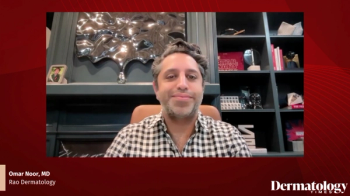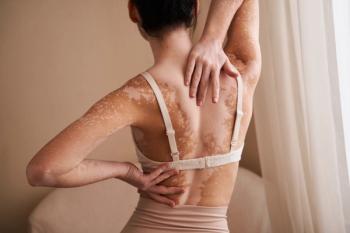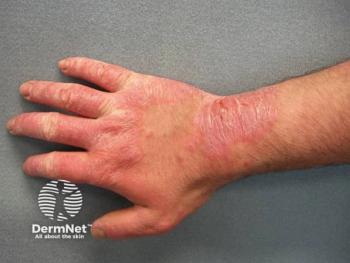
- Dermatology Times, June 2025 (Vol. 46. No. 06)
- Volume 46
- Issue 06
Dermatology Times June 2025 Print Recap
Key Takeaways
- Visible light, especially HEV light, contributes to hyperpigmentation in individuals with higher Fitzpatrick skin phototypes, with iron oxide formulations offering effective protection.
- The Clean Slate Free Tattoo Removal Program integrates medical students into dermatology practice, aiding social reintegration for formerly incarcerated individuals.
Learn more about the in-depth topics covered in the June 2025 print issue of Dermatology Times.
The June issue of Dermatology Times includes a collection of thought-provoking articles and topics ranging from visible light protection needs for diverse patients to oral ritlecitinib and nbUV-B for nonsegmental vitiligo management. Be sure to read the highlights from the issue below. Also, don’t miss a moment of Dermatology Times by signing up for our
Visible Light Protection: Needs and Strategies for Diverse Patients
Research advances within the photoprotection field demonstrate that visible light radiation (400-700 nm), which accounts for 45% of sunlight, can act synergistically with UV-A radiation to induce oxidative stress and cause both immediate and persistent skin darkening, particularly in individuals with Fitzpatrick skin phototype III and higher. We now understand that it is the blue-violet component of visible light, known as high-energy visible (HEV) light (415-455 nm), that is the main contributor to long-lasting hyperpigmentation in individuals with skin of color, as epidermal melanocytes can detect blue light through opsin 3 photoreceptors, which trigger melanin synthesis via tyrosinase activation.
Findings from several studies indicate that incorporating metal oxides, such as iron oxides, titanium dioxide (TiO2), and zinc oxide (ZnO), and other pigments into formulations offers visible light protection. Findings from a study by L’Oréal USA Research and Innovation, in collaboration with Pearl Grimes, MD, FAAD, demonstrated that iron oxide formulations provided superior protection against visible light-induced hyperpigmentation in patients with skin of color compared with a nontinted mineral sun protection factor (SPF) 50+ sunscreen. These initial findings suggested that iron oxide formulations offer a dual benefit: masking existing pigmentation while preventing further dyschromia caused by visible light exposure.
Ink to Impact: A Laser-Focused Mission in Justice and Dermatology
Service learning has become an essential component of modern medical education, allowing students to apply classroom knowledge in real-world clinical settings while addressing the needs of underserved communities. The University of California, San Diego (UCSD) has exemplified this through the Clean Slate Free Tattoo Removal Program, a dermatology-based initiative aimed at helping formerly incarcerated individuals reintegrate into society by providing free laser tattoo removal. What makes this program especially innovative is the integration of medical students into its clinical and operational framework, fostering early clinical exposure and a commitment to social justice.
Initially founded in 2016, the Clean Slate Program offers monthly clinics where volunteer dermatologists and residents provide laser tattoo removal services for individuals referred through law enforcement and community partners. Many patients seek the removal of gang-related or stigmatizing tattoos that hinder their employment prospects or personal growth. To meet increasing demand and growing student interest, UCSD expanded the program in the fall of 2024 to include a structured volunteer component for medical students.
Oral Ritlecitinib Plus nbUV-B Accelerates Repigmentation in Nonsegmental Vitiligo
Recent research in vitiligo has focused on gaining a better understanding of the autoimmune disease and developing treatments that best serve patients. Given its significant psychological impact, including depression, anxiety, impaired personal and social relationships, negative self-esteem, and impaired quality of life, vitiligo presents an imminent need for additional treatment options. Clinically, vitiligo is classified as segmental (ie, affects only 1 side of the body or a specific area, such as the hands or face) or as nonsegmental vitiligo (NSV; ie, depigmented macules appear symmetrically on various parts of the body, face, hands, and feet). NSV is the most common type of vitiligo.
Current vitiligo treatments aim to restore skin color or even out skin tone, but results can vary. Common treatment approaches include topical, oral, or injectable corticosteroids, calcineurin inhibitors, and narrowband UV-B (nbUV-B) light therapy, but no systemic pharmacological treatments are currently approved for NSV.
Beyond the Label: How AI Tools Such as SkinGPT Enhance Skin Care Understanding
In a field where visual results often matter as much as clinical ones, a new innovation is reshaping how dermatologists, patients, and brands understand and communicate product efficacy. Haut.AI, a science-driven beauty technology company cofounded by Anastasia Georgievskaya, is at the forefront of this transformation. Through SkinGPT and Generative Skin, Haut.AI brings artificial intelligence (AI) and dermatology together to offer a new and personalized visual experience in skin care evaluation.
“The inability to communicate clearly the effects of products, the lack of explainable materials and visuals of what products do, and our desire to address the gap in the data are what led to the creation of SkinGPT,” Georgievskaya said in an interview with Dermatology Times. Georgievskaya, a scientist with a background in biophysics and a passion for beauty, founded Haut.AI with a mission to fuse scientific rigor and AI with the dermatological space.
Articles in this issue
6 months ago
Nail Trends That Challenge Clinical Diagnosis6 months ago
Inside IL-17 Inhibitors Advancing Psoriasis CareNewsletter
Like what you’re reading? Subscribe to Dermatology Times for weekly updates on therapies, innovations, and real-world practice tips.



















